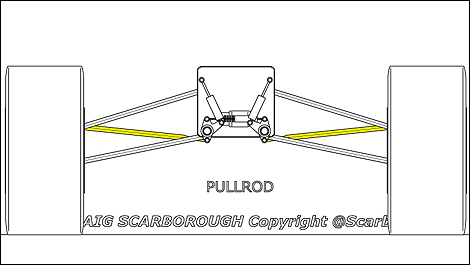Aug
7th
Stay connected Subscribe to our RSS feed
We read in the news that McLaren may follow Ferrari's lead in opting for innovative pull-rod front and rear suspension for its 2013 Formula 1 car. But what is the main difference between the two?
The pull-rod suspension has been introduced in Formula 1 eleven years ago when Gabriele Tredozi designed the 2001 Minardi.
This season, the Ferrari F2012 also uses this system while all other teams still rely on the traditional push-rod mechanism.
In very simple words, a push-rod uses a carbon- fibre rod to push and activate the rocker (that acts like the spring and damper) . The pull-rod is the opposite as the rod pulls on the rocker.
With the pull-rod layout the rockers are positioned lower in the chassis. According to Ferrari technical director Pat Fry, this set-up is a little lighter and has a slightly lower centre of gravity.
Also, in the case of the F2012 the pull-rod link is angled almost horizontally across the front suspension, which may help aerodynamically.
In his technical blog, Craig Scarborough explains that just as with the wishbones, the profile of the rod can be subtly altered within the rules to help control the wake from the wing and improve the airflow over the rear of the car.
He adds that despite appearances the pull-rod is as effective in moving the rocker for a given wheel travel as a pushrod. The important factor is the angle between the rod and the wishbone it is connected to, rather than the rods angle to the chassis.
The pull-rod suspension has been introduced in Formula 1 eleven years ago when Gabriele Tredozi designed the 2001 Minardi.
This season, the Ferrari F2012 also uses this system while all other teams still rely on the traditional push-rod mechanism.
 |
| Illustration: Craig Scarborough |
In very simple words, a push-rod uses a carbon- fibre rod to push and activate the rocker (that acts like the spring and damper) . The pull-rod is the opposite as the rod pulls on the rocker.
With the pull-rod layout the rockers are positioned lower in the chassis. According to Ferrari technical director Pat Fry, this set-up is a little lighter and has a slightly lower centre of gravity.
 |
| Comparison between the 2010 Ferrari 150 on the left with the traditional push-rods and the current F2012 on the right with the pull-rods. |
Also, in the case of the F2012 the pull-rod link is angled almost horizontally across the front suspension, which may help aerodynamically.
In his technical blog, Craig Scarborough explains that just as with the wishbones, the profile of the rod can be subtly altered within the rules to help control the wake from the wing and improve the airflow over the rear of the car.
He adds that despite appearances the pull-rod is as effective in moving the rocker for a given wheel travel as a pushrod. The important factor is the angle between the rod and the wishbone it is connected to, rather than the rods angle to the chassis.
 The latest auto news, reviews, prices, product and vehicle releases.
The latest auto news, reviews, prices, product and vehicle releases.